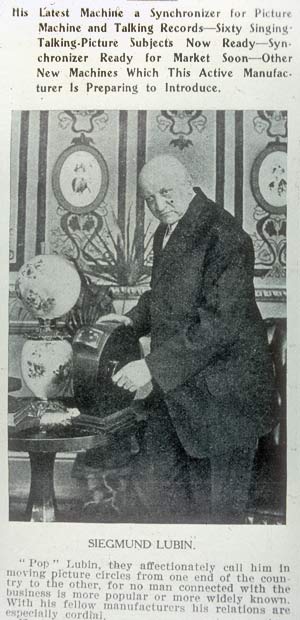An Introduction
Siegmund Lubin, a newly-arrived German-Jewish immigrant in 1876, had by 1912 became America’s first movie mogul, a powerhouse in the early moving picture era. A commercial genius and a master at self promotion, he was able to parlay his knowledge of cameras and lenses into one of the most commercially successful movie companies of the early silent era. The Betzwood studio was the flagship of his empire of studios and was world famous before bankruptcy brought Lubin’s self made world crashing down.
It was, however, a long way to the top. Lubin was born Siegmund Lubszynski, in what is now Poland, around 1841. His family were middle class Jews struggling to make ends meet, and the paucity of material comfort and discrimination that came with such modest beginnings forged an iron determination.
Despite the early death of his father he was able to graduate from Heidelberg University as an ophthalmologist. The skills and the knowledge of lenses he learned there would serve him well in the emerging technology of moving picture cameras. His life- long fascination and appreciation for technology would keep him at the forefront of an industry that was about to change the world.
As did many of his generation he sought economic opportunities in America. His first attempt in 1868 was unsuccessful though he found the United States far more accommodating on his second trip in 1876. Within a few years he had a thriving ophthalmology practice in Philadelphia, a wife and two daughters, and a desire to build an economic empire.
A daring entrepreneur, (and some would argue less than ethical), Lubin combined impeccable timing with keen observations of his community to recognize potential business opportunities. The biggest prospect, as he saw it, was moving pictures. By the late 1890’s, after several years of advances, the industry had rapidly begun to expand. There were many inventors, famous and not so famous, working on perfecting the cameras and projectors. As a business option however, it was only waiting for the right person to exploit its true potential. Lubin would quickly move in and cover all aspects of the film industry; manufacturing, distribution, and supply.
Lubin quickly recognized the public appeal movie exhibitions would have, as opposed to Thomas Edison, the most famous inventor involved in the race. He helped create a demand for film by advertising in popular entertainment magazines and soon demand outpaced supply. He was very astute at predicting what the public would want, catering to the lower classes, with which he was most familiar and comfortable. He created the first chain of movie theaters–seventeen theaters in six states by 1908–and set up a distribution system that supplied other exhibitors and theaters owners.
The manufacturing side of his business, the production of cameras, projectors and films, grew just as rapidly. From the back room of the optical shop and a rooftop studio on Philadelphia’s Arch Street in 1899, Lubin expanded to an entire building on Market Street by 1906, and again to a studio and factory that took up a whole city block in North Philadelphia by 1910.
By 1912 Lubin was ready to expand again, the “Lubinville” studio in North Philadelphia no longer meeting all his needs. He branched out, establishing branch studios in Florida and California. As the administrative and technological hub of this empire of studios, he also purchased the estate of Philadelphia brewer John F. Betz, some 20 miles northwest of the city, and established his biggest studio there. This was the pinnacle of Lubin’s personal and business success and the culmination of his dreams of economic victory and social acceptance. But already the seeds of his decline were evident.
Lubin faced mounting difficulties from which he would not be able to recover. The pace of technological advances had increased through the first decade of the century as did consumer tastes. Lubin kept up with the technological paces, but his storytelling lacked the artistic quality that the public was beginning to expect. This would plague him throughout the rest of his career despite repeated attempts to correct the shortcomings. He would also fail to completely understand the transition of single to multi-reel films, a natural evolution and part of the public’s demand for better narratives. Lubin gambled on the continued thriving of the nickelodeons which showed only single reel films, even while he spent a fortune to produce his own mutli-reel features. In the process he spread himself too thin and when the demand for single reel films disappeared, he could not recoup his losses or make ends meet. Legal difficulties and his fierce loyalty to Thomas Edison’s Motion Picture Patents Company cost him dearly as well. The First World War stripped away his foreign markets. By 1916, just four years after his triumphal opening of the Betzwood studio, Lubin was bankrupt. He made repeated attempts to stay involved in the movie industry, but he died on September 11, 1923, never able to recapture his past glories.


Does anyone know where I can find a copy of a documentary that J. Frank Brocklin made in 1914 about the First World war in Belgium. he made it for the Lubin Film Company.
I have an old film poster “Lubin Presents” The Drug Terror (Evils of Cocaine) Sociological Research Film Corporation in Co-Operation with Mrs. William K. Vandelbilt’s National Crusade. Does anyone know the history of this film?
Cool! Thanks for posting this! It really helped with my project!
Nice article. I was searching for some info on the Lubin Cineograph. Directions and Setup of the Cineograph. I recently purchased this machine an am trying to set it up and repair any damaged parts.